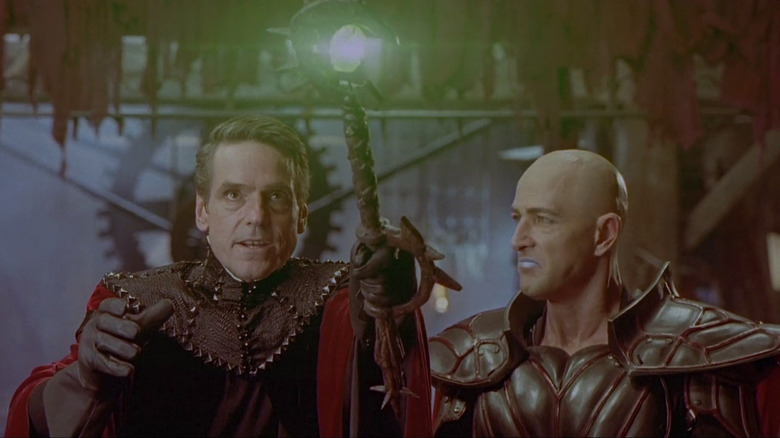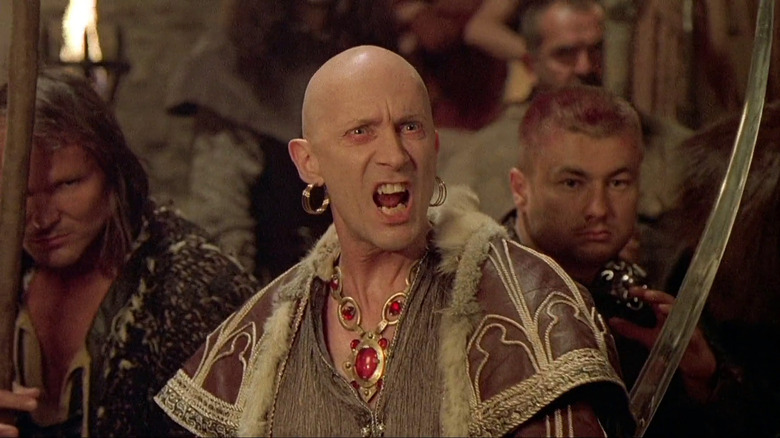Somehow, The 2000 Dungeons & Dragons Movie Got Two Straight-To-Video Sequels
"Dungeons & Dragons" was first conceived and designed by Gary Gygax and Dave Arneson in the early 1970s, and first published as a game in 1974. "Dungeons & Dragons" was derived from a 1971 medieval-themed game that Gygax had developed with Jeff Perren called "Chainmail," and both games centered on the fineries of medieval combat, using dice and statistics to determine damage given to, and inflicted by, foes. The game began as an underground phenomenon, essentially inventing a new class of nerd, and quickly grew into a subculture all its own — inspiring a genre now occupied by thousands of role-playing games. The game allows players to carefully construct characters — complete with a full set of stats, clothes, character traits, and skills — and send them on adventures overseen by a Dungeon Master who has to adjust the script of the players' story as they make new and unexpected decisions. It is full of spells, weapons, potions, battles, and oh so many monsters. It is played voraciously to this day.
"Dungeons & Dragons" was frequently looked at with suspicion by uptight, hand-wringing, Christian-inflected censorship groups concerned that the game was teaching children how to engage in legitimate witchcraft, or, at the very least, robbing kids of their ability to separate truth from fiction. This moral panic even led to the cheesy 1982 TV movie "Mazes and Monsters," an early work in Tom Hanks' filmography, about an RPG addict who takes the game too far. With squares breathing down its neck, "D&D" became even more popular, spawning a series of tie-in novels beginning in 1978, and serving as the basis for a three-season 1983 animated series. In 2022, many celebrities openly talk about their love of "D&D," and most adolescents cannot escape their youth without playing at least one game.
TSR, the company that owned "D&D," was looking to option film rights for their property as early as the 1980s, but no deal could ever be reached. It was in 1990 that an enterprising 19-year-old named Courtney Solomon, engaged in the subterfuge that he was working on a school economic assignment, contacted TSR about their woes. This would eventually lead to Solomon negotiating with the company about what might be needed to make a proper "D&D" feature film. As detailed by profiles in Wired and on Ain't It Cool News, Solomon would convince TSR to give him the film rights, and, at age 24, started the long journey of getting a "D&D" film made. Many huge directors sniffed around the project, including James Cameron, but nothing could be set in stone. After a decade of struggle, the fineries of this long-in-the-tooth — and ultimately exhausted — production finally came to fruition with a lower-than-expected budget, the umpteenth draft of the script, and with Solomon having to serve as director.
The result was ... well, read on, gentle paladins.
The 2000 film
The finished film, which hit theaters on December 8, 2000, was widely derided by just about everyone. Made on a relatively small budget of $45 million and shot in the Czech Republic, "Dungeons & Dragons" told the story of an evil wizard named Profion (Jeremy Irons, chewing more scenery than was built for the movie) who sought a magical staff that would allow him to control dragons. His rival was a gentle queen (Thora Birch) who was in the middle of a not-at-all-developed caste conflict between mages and ordinary citizens. In the middle of them was the film's central team of heroes: A Bop-cover-ready thief named Ridley (Justin Whalen), his "comedic" best friend Snails (Marlon Wayans), a nerdy wizard student (Zoe McLellan), a steely Elf warrior (Kristen Wilson), and a crass and unfunny Dwarf (Lee Arenberg). As our heroes adventure through the land stealing dragon staff components, they are tailed by the wonderfully campy, overacting, blue-lipped Damodar (Bruce Payne) who has a parasitic monster worm living in his brain. Speaking of camp, Richard O'Brien, the creator of "The Rocky Horror Picture Show" appears as a thief lord.
"Dungeons & Dragons" was roundly rejected, with critics razzing its low-fi FX, bad acting, and the awful story. It currently holds a mere 10% approval rating on Rotten Tomatoes, and opened to a paltry $7 million on its opening weekend. "Dungeons & Dragons" certainly deserves its reputation — it's grating, cheap, and bad — and the only defense you may hear of it in 2022 is that it functions well as a mockery object, well-suited for marijuana-fueled bad movie nights. Since 2000, the film has become quite notorious and is frequently brought up in discussions of the Worst Movies Ever Made.
The following year, New Line Cinema would strike gold with another fantasy epic, the better-received "Lord of the Rings: The Fellowship of the Ring" made by the director of "Meet the Feebles." With the public's attention now geared Tolkein-ward, "Dungeons & Dragons" became a fallow property in terms of film, and many brushed off Solomon's efforts as a failed attempt to significantly bring "D&D" to the masses.
The game, however, also underwent a significant change in 2000. TSR was bought by Wizards of the Coast in 1997, and their 2000 re-release of D&D streamlined the Basic and Advanced versions of the game into a single, simpler rendition. These changes kept the game popular, and "D&D" remained a steady presence in nerdy basements regardless of the success (or lack thereof) of the film. As such, in 2005, Warner Home Video elected to bolster "D&D's" film presence with a sequel.
Wrath of the Dragon God, aka The Elemental Might
Gerry Lively's 2005 sequel "Dungeons & Dragons: Wrath of the Dragon God" was not touched by Courtney Solomon and was not released under the New Line Cinema banner. Made for a budget of only $15 million (according to IMDb, a source that should be taken with a grain of salt), and shot in Lithuania, "Dragon God" brings back the character of Damodar (still Bruce Payne) as the central villain, and sets the action a full century after the events of the first film. Damodar is now an undead creature who seeks a magical orb that would grant him power over a sleeping black dragon. Mark Dymond plays the hero at the center of a ragtag group of warriors, assembled to stop him. Lux (Ellie Chidzey) is the fiercest in the land. For wisdom, there is Dorian (Steven Elder), and for magic, there is Ormaline the Elf Wizard (Lucy Gaskell).
While perhaps risible as an A-level feature film shouldered with a massively popular IP, there is something charming about "Wrath's" low-budget, 1990s-BBC-miniseries level of special effects and corny fantasy earnestness. While Payne's performance was seen as silly and over-the-top in the 2000 film, his gnashing feels more appropriate here.
"Wrath of the Dragon God" was also not a success, and few have seen it; indeed, this very article is meant to alert readers to its very existence. It's currently available on DVD on the second-hand market. It can be found bundled with the 2000 film, or paired with ... oh yes, dear readers, there was another sequel.
The Book of Vile Darkness
With the "Dungeons & Dragons" IP still having lost none of its cultural clout, a 2011 feature film was put into production. Also directed by Lively, "The Book of Vile Evil," based on a recent edition of the game, featured no returning characters or mythologies, and begins several millennia prior to the first film. Given the fantastical nature of "Dungeons & Dragons," however, the shifting time frames seem to have little impact on the technology or the state of civilization. The story revolved around an evil book that was made from the skin and blood of an evil wizard lord, and a modern-day adventurer named Grayson (Jack Derges) must quest with various warriors (Charlotte Hunter among them) to seek revenge ... also a horn ... magic ... dragon ... vile evil ... wyverns.
Judging by the above trailer, "The Book of Vile Evil" seeks a darker tone than its predecessors, bringing in notions of vile rot and decay, rather than mere world domination via dragon armies.
None of these three films is widely celebrated, and the issue might be with the "Dungeons & Dragons" game itself. The game is designed to allow the players to create their own characters and dictate their own adventures. It is about the free will of the adventurer. Apart from a medieval fantasy world as a backdrop, there are no central stories or characters in "Dungeons & Dragons" that define the franchise. All that must be required are the lizards and oubliettes of the title. After that, there is nothing separating a "Dungeons & Dragons" film from any other generic fantasy picture. The name may be recognizable, but the themes and tales from within the universe are something you dictate to the world, not the other way around.
This hasn't stopped people from trying. A fourth "Dungeons & Dragons" feature film — to be directed by Jonathan Goldstein and John Francis Daley, and starring Chris Pine and Michelle Rodriguez — is set to be released in theaters on March 3, 2023, and this one will be a large-budget studio film (it will be put out by Paramount) meant to revitalize the game's film potential. Audiences can only cross their fingers and hope this new version simply isn't as bad as what they have seen so far.

